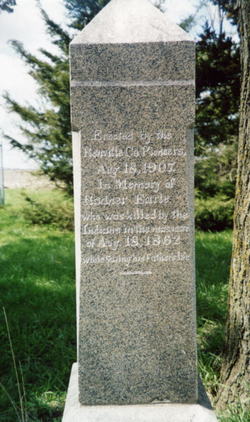These two sons, Chalon and Ezmon, were with the Joseph R. Brown burial party which was sent forth from Fort Ridgely on August 31, 1862. They found Radnor's body on the prairie, and buried him there. They were both fortunate to survive the battle of Birch Coulee, when the Dakota attacked the burial parties encampment on September 2. Sometime in the 1860's, the family erected a gravestone with a lamb on top over Radnor's lone grave, facing in the direction from which the Dakota had come that fateful morning. The surviving family then moved to LeMars, Iowa. Jonathan died there in 1874, and it was his wish that Radnor's gravestone be moved to be next to his in LeMars. But oddly enough, Radnor's remains were left there. In 1907, another marker was placed on Radnor's grave, but it too was moved in the early 1980's to a nearby roadside rest. This roadside rest is on U. S. Highway 71, about 3.6 miles north of Minnesota Highway 19 at Morton. So Radnor, who at different times had two gravestones or markers, now has none. The inscription on the gravestone at LeMars reads "In Memoriam. Radnor Clifton, Son of Jonathan W. Earle, Amanda M. Earle, Born Feb. 17, 1847, Massacred Aug. 18, 1862 By the Sioux, while defending his father. Noble boy, too good for earth, In Heaven rest evermore." The Dakota were also called the Sioux. The marker in Renville County reads "Erected by the Renville Co. Pioneers, Aug. 18, 1907. In Memory of Radnor Earle who was killed by the Indians in the Massacre of Aug. 18, 1862, while saving his Father's life." Radnors story is related on pages 39 and 40 of "Dakota Uprising Victims: Gravestones & Stories," published in 2007 by Curtis Dahlin.
These two sons, Chalon and Ezmon, were with the Joseph R. Brown burial party which was sent forth from Fort Ridgely on August 31, 1862. They found Radnor's body on the prairie, and buried him there. They were both fortunate to survive the battle of Birch Coulee, when the Dakota attacked the burial parties encampment on September 2. Sometime in the 1860's, the family erected a gravestone with a lamb on top over Radnor's lone grave, facing in the direction from which the Dakota had come that fateful morning. The surviving family then moved to LeMars, Iowa. Jonathan died there in 1874, and it was his wish that Radnor's gravestone be moved to be next to his in LeMars. But oddly enough, Radnor's remains were left there. In 1907, another marker was placed on Radnor's grave, but it too was moved in the early 1980's to a nearby roadside rest. This roadside rest is on U. S. Highway 71, about 3.6 miles north of Minnesota Highway 19 at Morton. So Radnor, who at different times had two gravestones or markers, now has none. The inscription on the gravestone at LeMars reads "In Memoriam. Radnor Clifton, Son of Jonathan W. Earle, Amanda M. Earle, Born Feb. 17, 1847, Massacred Aug. 18, 1862 By the Sioux, while defending his father. Noble boy, too good for earth, In Heaven rest evermore." The Dakota were also called the Sioux. The marker in Renville County reads "Erected by the Renville Co. Pioneers, Aug. 18, 1907. In Memory of Radnor Earle who was killed by the Indians in the Massacre of Aug. 18, 1862, while saving his Father's life." Radnors story is related on pages 39 and 40 of "Dakota Uprising Victims: Gravestones & Stories," published in 2007 by Curtis Dahlin.







